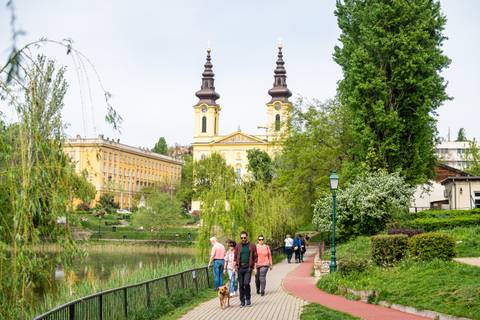The area around Keleti station is full of noise and chaos, from where busy Thököly út heads north-east to intersect with Dózsa György út and – important for this story – the mansions of Istvánmező. Here, at the very onset of this avenue, stands a beautiful, monumental building: Szenes-ház, the ‘House of Coal’. A breathtaking example of Hungarian Art Nouveau, its interior and staircase have been recently renovated – and, while the exterior awaits its own restoration, it remains an impressive and remarkable façade.
Szenes House got its name from its builder – Mór Szenes and his wife Regina Stern – despite the fact that soon after its completion, ownership of the building had already migrated to another keeper. The husband-and-wife team had decided in the early 1900s to build an imposing-looking house at the intersection of Thököly út (then Csömöri út) and Dózsa György út (then Aréna út), with the plans being completed in 1905.
Only a year later, in 1906, Szenes House was erected in all of its Art Nouveau glory. The Szenes family did not own it outright for long, however, as in 1907 the property transferred to Countess István Bossányi of Nagybossány and Kispron (née Emilia Fölsinger). Nevertheless, Mór Szenes, the chief inspector of the insurance office, and his family remained tenants for a long time.
The floors of the massive house were occupied
with apartments, with a wine cellar set up in the basement, and a restaurant
with a garden designed for the ground floor. The restaurant was never
actualised, however, as it was instead turned into the Polgári Casino, headed
by Mór Szenes himself, and occupying the entire ground floor tract.
Even this
was not the final form of Szenes House, though: the new owner had different
ideas for the structure, and eventually apartments were set up on the ground
floor, similar to those above.
The name of the architect, István Nagy Jr, may not be well known, but he was a student and follower of the great Ödön Lechner, whose influence shows here.
Like other Art Nouveau creations, Szenes House is rife with folk-art motifs, winding garlands, wrought-iron butterflies, floral decorations and vibrant reds, yellows, blues and pinks splashed throughout the designs. It is even referred to as a poor man’s Lechner, as the carved flowers are not ceramic, but plaster, presumably due to cost.
The inside is equally impressive, especially after recent renovations have refreshed the paint and renewed the architectural detail which make the building so remarkable. While the exterior still awaits its revival, it remains nonetheless a superb example of Hungarian Art Nouveau, and one which any architecture enthusiast would be remiss to miss.



